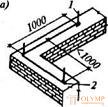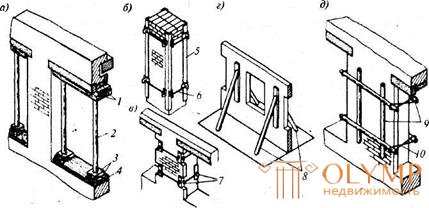
Negative temperatures have a strong influence on the physicomechanical processes occurring in the newly laid masonry. The hardening of the solution in the masonry stops due to the transition of the water of the solution into ice, and the hydration reaction of the cement, which began with the laying of the solution, diminishes and stops as the temperature of the solution decreases. Freezing solution turns into a solid mechanical mixture of cement (lime), sand and ice. Water, going into ice, increases in volume, which leads to an increase in the volume of the solution, as a result of which it loosens, the bonds between its particles are broken, and the strength decreases sharply. An ice film forms on the surface of the stones, and this additionally reduces the adhesion strength of the mortar to the stone. As a result, with early freezing of the laying of its ultimate strength at the age of 28 days. It turns out to be significantly lower than the strength of normally hardened masonry.
In the lime mortar during freezing, the hardening process also stops, but unlike the cement mortar, after hydration, the hydration process does not resume.
To perform masonry in winter conditions using the method of freezing. Its distinctive features are as follows:
■ at a positive temperature after thawing, the masonry will continue to gain its strength if the solution has gained critical strength, which is usually more than 20% of the brand strength, by the time of freezing;
■ the freezing method is not applicable for eccentrically compressed structures with significant eccentricity and structures subjected to vibration, as well as in rubble masonry, in walls of butobeton, in arches;
■ use only cement and complex mortars, since lime and lime-clay ones do not retain the ability to harden after thawing;
■ vehicles in which the solution is delivered to the construction site must be warmed, a portion of the solution is supplied to the site of work only for 20 ... 30 minutes of work and at a solution temperature not lower than + 20 ° С;
■ a log of control over the performance of the brickwork and its defrosting is obligatory, since, due to the unequal density of the mortar, uneven precipitations are possible during thawing.
In practice, the following methods of laying in winter conditions are used ..
A clean freezing method, in which the laying is carried out on the heated components of the solution. Water is heated in boilers or registers to 80 ... 90 ° С, sand is warmed to a positive temperature, or heated to 60 ° С. Apply cement or cement-lime solutions with a minimum temperature At the time of laying is not lower than + 20 ° C at an ambient temperature of 0 ° C. When the ambient temperature decreases by several degrees, by the same degree, it is necessary to raise the temperature of the applied mortar. The laying is carried out on a brick cleared of snow and ice. The solution freezes, not having gained brand strength, but, having already acquired critical strength, therefore, at a positive temperature, strength will continue to grow, but masonry usually does not gain brand strength. To obtain brand strength, a brand of solution is used that exceeds the design grade of one or two grades.
Masonry lead to the entire width of the wall at the same time. It is desirable to ensure that the mortar freezes after laying 5 ... 6 subsequent rows of masonry, which will provide better compaction and reduce the draft in the spring. In order to increase the strength of the masonry, metal bonds are arranged at the points of junction and intersection, usually at the level of the overlap of each floor (Fig. 13.1). Prefabricated elements are mounted immediately after the completion of the masonry of the floor, and floor slabs - with mandatory anchoring in the joints of the outer mile masonry.
|
|
|
Fig. 13.1. Strengthening of a laying by steel communications in the course of works: a - in the corners; b - in the intersection of the walls; in - in places of an adjunction of columns to walls; 1 - vertical anchors with a diameter of 10 ... 12 mm; 2 - horizontal connections with a diameter of 8 ... 10 mm; 3 - horizontal anchor with a diameter of 8 ... 10 mm | ||
Freezing with antifreeze additives. Cement and mixed solutions with antifreeze chemical additives provide curing at a negative temperature of at least 20% of the design, and under favorable weather conditions during the winter months, the solution can acquire up to 70 ... 80% of brand strength. As a result of the use of solutions with antifreeze additives, the strength of the masonry in winter conditions is not less than the strength of a similar masonry made in the summer.
Solutions with additives Z ... 6% sodium chloride, calcium, ammonium allow you to push the freezing point of the solution to -10 ° C. For buildings with a permanent stay of people, these solutions are not allowed to use, use only potash and 3 ... 6% sodium nitrite solution.
Brick and stone when laying on solutions with antifreeze additives cleaned of snow and ice. At frosts up to -15 ° C, laying is carried out on solutions with the addition of sodium nitrite (5 ... 10% by weight of cement). The workability of such solutions is maintained in the cold for 1.5 ... 3 hours. Solutions with sodium nitrite at temperatures below –15 ° C almost do not gain strength, but at higher temperatures, the solutions come to life again and their hardening continues.
At frosts up to -30 ° C, potash is injected into masonry mortars (5 ... 10% by weight of cement) and the retarder setting the mortar LST. The setting process of the solution is slowed down, but remains quite intensive and therefore it is necessary to produce a solution within 1 hour. Additives of potash can cause corrosion and destruction of silicates. Solutions with such additives are not recommended for use in the construction of silicate brick structures.
The use of quick-hardening solutions of the composition 1: 3 on a mixture of alumina cement (30%) and Portland cement (70%). Taking into account the preheating of the mixing water, the solution quickly gains critical strength.
Electric masonry heating is used for small amounts of work for the busiest piers and pillars of the lower floors of high-rise buildings (fig. 13.15). The laying which is subject to electrical heating is carried out only on cement mortar. The grades of the mortar are taken in accordance with the project, but not less than 50. Electric heating is performed using metal rods with a diameter of 5 and 6 mm, which are placed in the laying process - in a row 15 cm apart from each other with release for trimming the masonry and repeated after 2 .. .3 masonry rows. With the release of 4 ... 5 cm, it is possible to connect these rods to wires with a voltage of 127, 220 and 380 V. Warming occurs by converting electric current into thermal energy as it passes through the solution between the electrodes. In the process of gaining a solution of strength, the strength of the current begins to fall, so usually the heating is stopped when only critical strength is acquired.
|
b) |
In the reinforced masonry of the pillars, the role of electrodes is performed by steel grids. The masonry sections between the grids or electrodes connected to different phases of the current are
Fig. 13.2. Electric masonry heating schemes:
a - brick wall; b - brick pillar; 1 - electrical network; 2 - plate electrodes; 3 - tap; 4 - wires; 5 - steel mesh
resistance, and themselves grow 





 thieves with the presence of a liquid phase - conductors of electric current. As a result of the passage of electric current, the mortar joints are heated to a temperature of 30 ... 35 ° C, the solution hardening process is significantly accelerated. Electric masonry heating is continued until the mortar sets a strength of at least 20% of brand strength.
thieves with the presence of a liquid phase - conductors of electric current. As a result of the passage of electric current, the mortar joints are heated to a temperature of 30 ... 35 ° C, the solution hardening process is significantly accelerated. Electric masonry heating is continued until the mortar sets a strength of at least 20% of brand strength.
Reinforcement of masonry with the arrangement of nets through 1 ... 4 rows and rods in the net after 5 ... 7 cm, with the establishment of nets in junction and interfacing increases the strength of the masonry after thawing 2 times.
Laying in hot houses, insulated from outside air, in volumes in which the temperature above + 10 ° C is created with heated air is rarely performed, usually for separate, isolated sections of masonry.
Distinctive features of brickwork in winter conditions:
■ reduce the size of plots, increase the number of bricklayers, provide a quick erection of masonry in height with the mandatory and simultaneous execution of work immediately on the entire grab;
■ with a multi-ligation system, vertical longitudinal seams are tied at least every 3 rows;
■ the stock of the solution at the workplace is allowed only for 20 ... 30 min of work, the box must be insulated and equipped with heating;
■ it is not allowed to lay wet and icy bricks into the structure, it must be dried;
■ it is not allowed to leave the mortar on the upper layer of the brickwork during breaks in work.
The increase in the cost of winter laying on a conventional cement mortar with the freezing method is 8 ... 12%; on quick-hardening solutions - 10 ... 15%; with solutions with antifreeze additives -12 ... 20%; when using electric heating - 15 ... 20%; in hot houses - 30% and more.
Prior to the beginning of the thawing of the masonry in the spring, measures are being taken to unload the structural elements of the masonry or strengthen them. To unload the walls in the openings, they install racks on the wedges, allowing them to adjust their position as the masonry settles (Fig. 13.3, a). Sometimes use metal racks with jacking supports. To reduce the load from the runs under their ends sum racks, also supported on wooden wedges. Increasing the bearing capacity and ensuring the stability of the pillars is ensured by installing steel holders or inventory collars from metal corners tightened with bolts (Fig. 13.3, b, c). 
Fig. 13.3. Masonry reinforcement during thawing:
and - a wall unloading racks; b - pillars and walls of the steel ferrule; in - the same, inventory clips; d - free-standing walls with bilateral braces; d - high walls with double-sided clamps; 1 - board; 2 - stand; 3 - wedges; 4 - wooden lining; 5 - steel corner; b - coupling bolt; 7 - collars with coupling bolts; 8 - struts; 9 - logs; 10 - wire twist
Sections of internal free-standing walls, the height of which is more than 5 times greater than their thickness, are temporarily fixed with double-sided braces (Fig. 13.3, d); high walls are fastened with double-sided clamps (fig. 13.3, d).
Что бы оставить комментарий войдите
Комментарии (0)